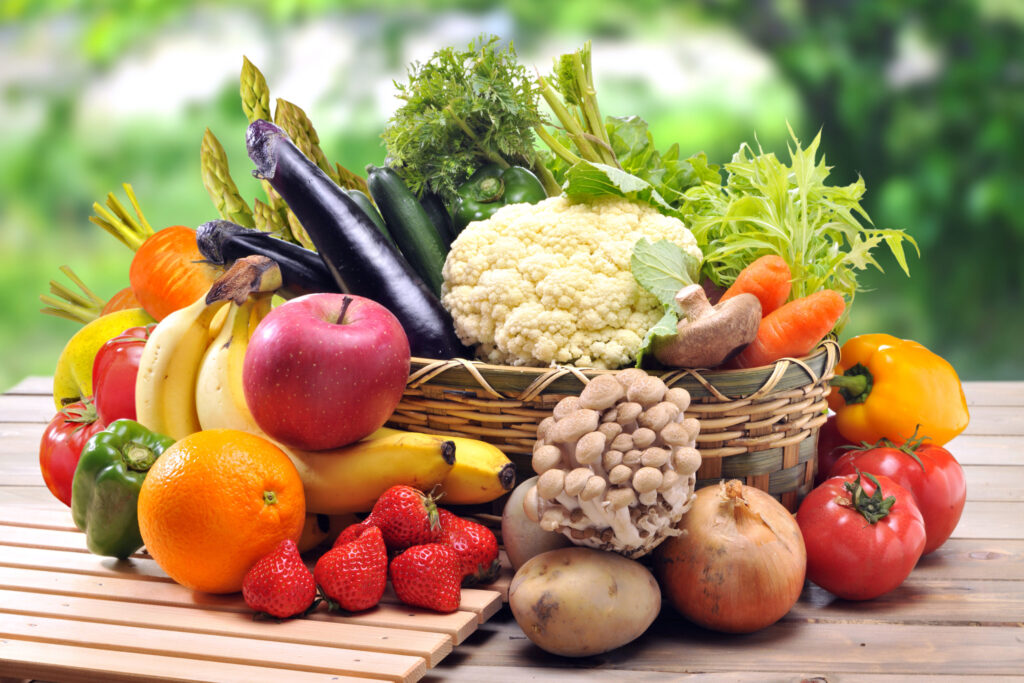Summer is the perfect time to take a look at your current eating habits and determine if you could use a few extra veggies and fruits during your day.
More than 90% of both adults and children are not getting enough fruits and vegetables on a daily basis. The dietary Guidelines for Americans and the MyPlate Nutrition Guide are recommending to follow 2 simple suggestions:
• Fill half of your plate with vegetables and fruits at every eating occasion (including snacks).
• Fresh, frozen, canned, and dried can all count towards your daily count. Do be careful with added sugars and sauces.
The actual number of cups of fruits and vegetables you need depend on several factors: age, sex, activity level. Check out the basic adult guidelines below for suggested servings:
Source: Centers for Disease Control and Prevention “Know the amounts you need each day”
Why should we eat more fruits and veggies?
Aside from being delicious and cost-effective, eating fruits and veggies are the best way to protect one’s health in the long run. Consuming more fruits and vegetables is associated with reduced risk of developing many chronic diseases including:
- Heart disease
- Strokes
- High blood pressure
- Some types of cancers
- Improve eye functions
- Improve digestion
- Diabetes
They are filled with many nutrients that are under consumed in the U.S, including:
- Vitamins A
- Vitamin C
- Vitamin K
- Potassium
- Fiber
- Magnesium
In addition to being chock full of vital nutrients, fruits and veggies are also low in calories, meaning they can help replace higher calorie foods that can lead to weight gain while being easy on the wallet and improving a wide range of biological functions.
Planning and prepping in advance is the key for most changes in our lives. Here are some helpful tips for increasing your daily intake of fruits and vegetables.
- Have crunchy vegetables in the place of chips. Pair along with your favorite low-fat salad dressings or dips.
- Make your own thin crust pizza with a variety of toppings such as: green peppers, tomatoes, broccoli, mushrooms and zucchini.
- Keep cut up vegetables and fruits in sealed containers in your refrigerator at all times. Grab those for snacks, side dishes, or as a quick bite prior to a meal. Some favorites include: broccoli, cauliflower, carrots, cherry tomatoes, red/green/yellow peppers, snap peas, cucumbers, radishes.
- Stuff sandwiches with extra fruits and veggies. Add sliced pineapple, tomatoes, spinach leaves, cucumbers, peppers, apples, onions.
- Load up your omelet with a variety of veggies. Try broccoli, peppers, carrots, spinach, onions, or squash as add ins.
- Add grated vegetables such as carrots, spinach, and zucchini to meat loaf, pasta sauce, lasagna, mashed potatoes, and rice dishes.
- Load up your freezer with a variety of frozen vegetables to steam, toss in a stir-fry, or for a quick side dish.
- Choose fruit for your dessert. Pair with vanilla yogurt dip or sprinkle with cinnamon and chopped nuts.
With over 200 common varieties of fruits and vegetables we have to choose from in the supermarket, switch your selections up and try some new types! Every step you take to add more fruits and vegetables will help you and your family live their best life. For additional ideas and recipes including fruits and vegetables check out the Blue Sky MD Pinterest page.



